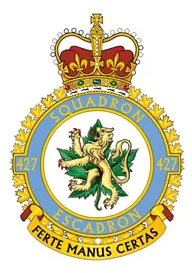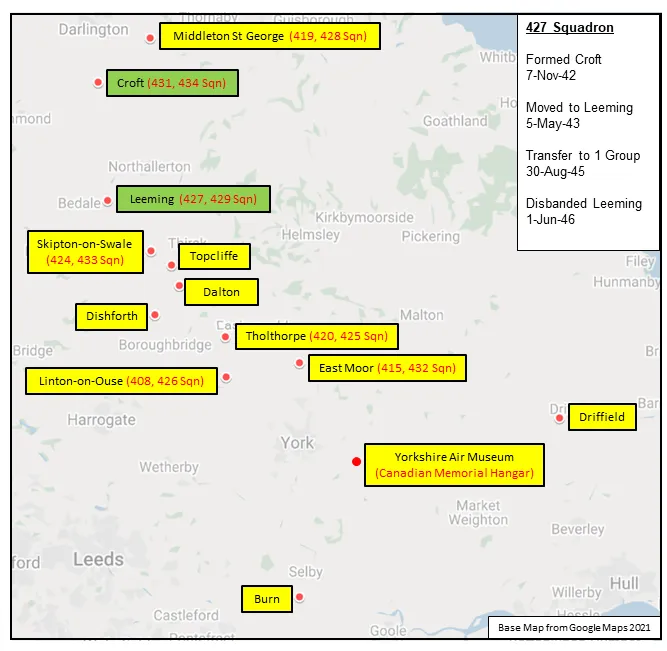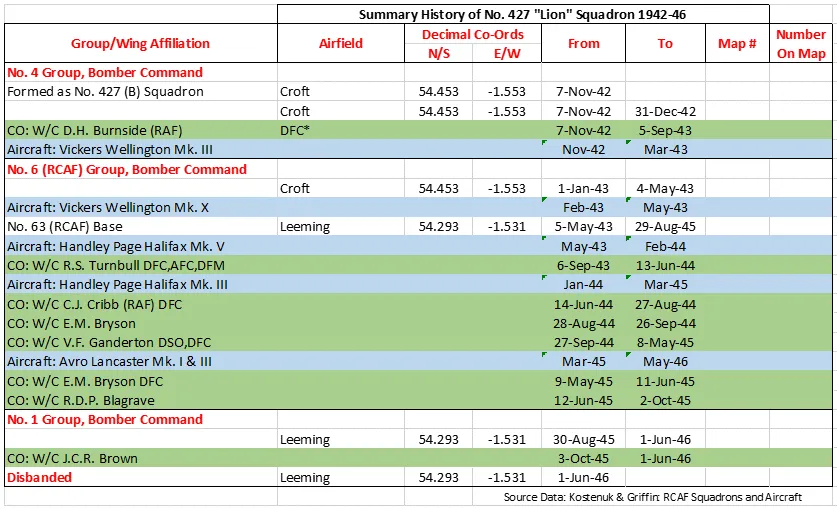Vandekerckhove, George Pierre Cornelius
Killed in Action 1943-08-31
Service
RCAF
Unit
427 (B) Sqn- Squadron
Ferte Manus Certas Strike sure
Base
RAF Leeming
Rank
Pilot Officer
Position
Pilot Officer
Service Numbers
J/17326
Target
 Berlin Germany
Berlin Germany
427 Lion Squadron (Ferte Manus Certas) RAF Leeming. Halifax V aircraft EB 251 ZL-T was believed shot down by a night fighter ten miles north-west of Osnabruck, Germany at Bramsche during an operation to Berlin, Germany
Pilot Officer GPC Vandekerckhove DFC (RCAF), FS JA Albert (RCAF), Warrant Officer Class 2 JJ McLean (RCAF), Sergeant E Bartlett (RAF), FS CC Gofton (RAFVR) and Pilot Officer AE Young (RAFVR) were all killed in action
Sergeant WA Williamson (RCAF) and Sergeant AD Rothwell (RAF) survived and were taken as Prisoners of War
The citation for Pilot Officer Vandekerckhove's DFC notes two events: That on a test flight (date unknown, but before August, 1943) the aircraft's dinghy deployed in flight and fouled the tail. Pilot Officer Vandekerckhove maintained control, ordered his crew to bail out and then made a successful safe landing.On March 5,1943 427 Squadron Wellington III aircraft Z 1572 ZL-Q, Pilot Flight Sergeant GPC Vandekerckhove, evaded an attack by a night fighter reported as damaged by the tail gunner, Sergeant JJ McLean, but later had an engine burst into flames. The fire was extinguished, but the propeller broke off. The crew managed to return to England on one engine and land, Flight Sergeant Vandekerckhove, Sergeant JJ McLean, Sergeant WA Williamson, Sergeant LE Moyler (RAF) and Sergeant AD Rothwell (RAF) safe (R Koval, FF Years, R Allenby)
This aircraft was the subject of a colour photo session when flying with 419 Squadron as VR-Q "Queenie" which has been widely distributed, and was also the subject of a diecast model by Corgi (Awards)
 427 Squadron Halifax V EB251 ZL-T P/O. Vandekerckhove RAF Leeming
427 Squadron Halifax V EB251 ZL-T P/O. Vandekerckhove RAF Leeming
Halifax EB251
Handley Page Halifax

The Handley Page Halifax is a British Royal Air Force (RAF) four-engined heavy bomber of the Second World War. It was developed by Handley Page to the same specification as the contemporary twin-engine Avro Manchester.
The Halifax has its origins in the twin-engine HP56 proposal of the late 1930s, produced in response to the British Air Ministry's Specification P.13/36 for a capable medium bomber for "world-wide use." The HP56 was ordered as a backup to the Avro 679, both aircraft being designed to use the underperforming Rolls-Royce Vulture engine. The Handley Page design was altered at the Ministry to a four-engine arrangement powered by the Rolls-Royce Merlin engine; the rival Avro 679 was produced as the twin-engine Avro Manchester which, while regarded as unsuccessful mainly due to the Vulture engine, was a direct predecessor of the famed Avro Lancaster. Both the Lancaster and the Halifax would emerge as capable four-engined strategic bombers, thousands of which would be built and operated by the RAF and several other services during the War.
On 25 October 1939, the Halifax performed its maiden flight, and it entered service with the RAF on 13 November 1940. It quickly became a major component of Bomber Command, performing routine strategic bombing missions against the Axis Powers, many of them at night. Arthur Harris, the Air Officer Commanding-in-Chief of Bomber Command, described the Halifax as inferior to the rival Lancaster (in part due to its smaller payload) though this opinion was not shared by many of the crews that flew it, particularly for the MkIII variant. Nevertheless, production of the Halifax continued until April 1945. During their service with Bomber Command, Halifaxes flew a total of 82,773 operations and dropped 224,207 tons of bombs, while 1,833 aircraft were lost. The Halifax was also flown in large numbers by other Allied and Commonwealth nations, such as the Royal Canadian Air Force (RCAF), Royal Australian Air Force (RAAF), Free French Air Force and Polish forces.Wikipedia
 National Air Force Museum of Canada
National Air Force Museum of Canada
427 (B) Sqn Ferte Manus Certas ("Lion")
History of the Squadron during World War II (Aircraft: Wellington III, X, Halifax III, V, Lancaster I, III)

427 Squadron was the RCAF's 25th squadron and eighth bomber squadron to be formed overseas in WWII. It was formed at Croft, Yorkshire, England on 7 November 1942 as part of No 4 Group of RAF Bomber Command. With squadron code letters ZL it flew Wellington Mk III aircraft. On 1 January 1943 it joined No 6 (RCAF) Group, remaining at Croft until May of 1943, when it moved to Leeming, Yorkshire , where it remained for the rest of the war in Europe. Its duties were to take part in strategic and tactical bomber operations. It briefly re-equipped with Vickers Wellington Mk X before acquiring Handley Page Halifax Mk V aircraft in May 1943. In January 1944 it re-equipped again with the improved Halifax Mk III. Finally it was equipped with Avro Lancaster Mks I and III in March 1945. After the termination of hostilities in Europe, the squadron remained in England and transferred to No 1 Group. It participated in operation EXODUS, the repatriation of POW's and operation DODGE, bringing back British troops from Italy. The squadron disbanded at Leeming on 1 June 1946.
In the course of WWII the squadron flew approximately 3300 operational sorties in the course of which either 88 (Moyes) or 90 (Kostenuk) aircraft were lost and approximately 10,300 tons of bombs were dropped. The squadron earned 4 DSO's, 147 DFC'c and 6 Bars to DFC, 1 AFC, 2 CGM's, 16 DFM's and 8 MiD. Battle Honours were: English Channel and North Sea 1943-45, Baltic 1944-45, Fortress Europe 1943-44, France and Germany 1944-45, Biscay Ports 1943-44, Ruhr 1943-45, Berlin 1943-44, German Ports 1943-45, Normandy 1944, Rhine, Biscay 1944. Wikipedia, Moyes, Kostenuk and Griffin
Squadron History (Bomber Command Museum PDF)
Maps for Movements of 427 Squadron 1942-46

427 Squadron History Summary 1942-46

History of the Squadron Post-WWII (Aircraft: Sabre 2, 5, 6, Starfighter, Kiowa, Twin Huey, Griffon)
The squadron was reactivated on 1 August 1952 as a fighter squadron in the Air Defence Command, based in St Hubert, Quebec and equipped with Canadair F-86 Sabre Mk 2s. The Squadron moved on to Sabre Mks. 5 and 6 while working out of St Hubert before deploying to Zweibrücken, Germany and becoming a part of 3 Wing, in March-April 1953. The Squadron continued in this role, operating out of Germany, for another decade, participating in many multi-national NATO exchanges and exercises with destinations including; Rabat, Morocco, Decimomannu, Sardinia and France. The squadron moved to Grostenquin, France in June 1962, but was inactive pending its conversion to the CF-104 Starfighter. On 15 December 1962, the Squadron was deactivated as a Fighter squadron and reactivated on the 17th as a Strike/Attack squadron, becoming the first Canadian squadron to be equipped with the Starfighter. This change in aircraft necessitated changes in training and tactics. In 1969 the squadron moved from Zweibrücken to Baden-Soellingen , and with that, a change from 3 Wing to 4 Wing.
The Squadron disbanded again on 1 July 1970 and was re-established on 1 January 1971 as a Tactical Helicopter Squadron with 10 Tactical Air Group of Mobile Command, later simply called ‘Air Command.’ The first helicopter used after this transition was the CH-136 Kiowa light observer helicopter and, simultaneously, the CH-135 Twin Huey utility helicopters. The Squadron participated in many operations, including: Norway, Egypt, Sinai and Central America. After switching to a fleet of only CH-135 Twin Hueys in 1992, the squadron deployed to Somalia in 1993 and to Haiti on Operations. In July 1997 the Squadron received the BELL CH-146 Griffon Helicopter fleet to replace the Twin Huey. By 1999, the Griffon’s had participated in operations in Canada and in Honduras. The early 2000’s saw rotations going to Bosnia.
On 1 February 2006, 427 Squadron became part of Canadian Special Operations Forces Command (CANSOFCOM), as a Special Operations Aviation Squadron (SOAS), with the responsibility of providing air capability to various units with the Canadian Special Forces Command, where it remains today, located at Canadian Forces Base Petawawa, Ontario . In recent years, 427 SOAS participated in Exercise FLINTLOCK, an annual regional exercise among African, Western and United States counterterrorism forces, in multiple countries in West Africa. It also deployed to the Middle-East as part of Operation IMPACT, the Canadian Armed Forces mission to build the military capabilities of Iraq, Jordan and Lebanon, and set the conditions for their long-term success. 



 Canadian Virtual War Memorial
Canadian Virtual War Memorial Commonwealth War Graves Commission
Commonwealth War Graves Commission www.findagrave.com
www.findagrave.com



 Halifax Heavy Bomber WWII
Halifax Heavy Bomber WWII Wikipedia Halifax Bomber
Wikipedia Halifax Bomber